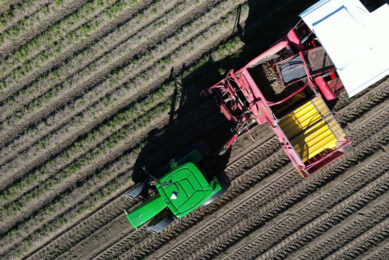Crop sensors control precise slurry/manure application

By connecting a crop sensor with an intelligent NIR-sensor equipped slurry tank, German companies Fritzmeier and Zunhammer aim at applying the right amount of nitrogen or phosphorous depending on crops’ needs.
Back in 2008, Zunhammer was the world’s first company introducing a NIR-sensor on slurry tanks to apply slurry/manure nutrient wise instead of volume wise. Its technology called VAN-Control 2.0 enables site-specific variable rate application of nitrogen (N) and phosphorous (P2O5) irrespective of the dosing rate in m3/ha.
NIR-Sensor analyses slurry/manure
The NIR-sensor analyses the slurry/manure while filling the tank and while applying the slurry/manure. This way it determines the quantity of nitrogen (N), ammonium (NH4), phosphorous (P2O5), potassium (K) and dry matter in the tank, in kg/m3.
Text continues underneath image
Upon application, farmers and contractors can apply the slurry/manure in m3/ha, in kg N per ha or in kg P2O5 per hectare. The applied amounts of all nutrients, the dry matter and the volume are recorded site-specific. Calibration curves for biogas/digestate and cattle and pig manure are available and those for poultry manure currently are in development.
According to company owner Sebastian Zunhammer jr., about 100 VAN-Control systems are currently in use, of which several on non-Zunhammer slurry tanks.
Sensor-controlled
Zunhammer and Fritzmeier are now adding sensor-controlled application to the variable rate application of slurry/manure. The 2 Fritzmeier Isaria crop sensors fitted in front of the tractor determine the biomass (vegetation) index of the underlaying crop, for instance grass or cereals and calculate, based on calibration curves, the exact amount of nitrogen needed.
Text continues underneath images
If the tank is not equipped with VAN-Control, then it is still possible to have the crop sensors determine the required volume in m3/ha and apply this accordingly and variable rate.
And although the technology was presented in cooperation with Zunhammer, the Isaria sensors can basically control any type of slurry tank for variable rate application, with or without a NIR-sensor on board.
Also read: John Deere Manure Sensing system DLG certified
The video below shows how the Fritzmeier Isaria crop sensors work
Join 17,000+ subscribers
Subscribe to our newsletter to stay updated about all the need-to-know content in the agricultural sector, two times a week.



